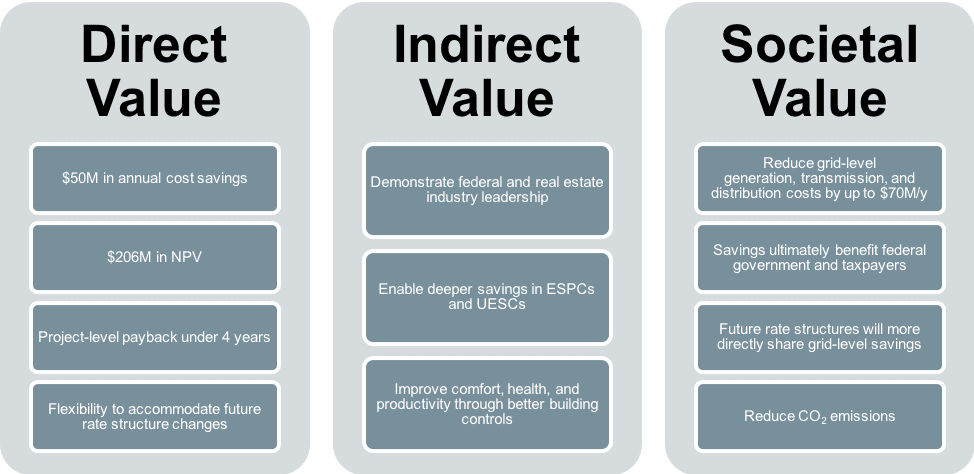
The Opportunity to Save Money, Energy, and Carbon With Grid-Interactive Efficient Buildings
This blog coincides with the launch of Rocky Mountain Institute’s (RMI’s) latest report, Value Potential for Grid-Interactive Efficient Buildings in the GSA Portfolio: A Cost-Benefit Analysis. The report provides lessons that could help any building owner to unlock the cost-, energy-, and carbon-savings potential of grid-interactive efficient buildings and is based on our work with the US General Services Administration.
If your building could communicate with the electric grid to save you money and lower your carbon footprint, would you be intrigued enough to explore how?
Every second of every day, the grid completes one-way transactions with our homes, offices, corner stores, and every building in between to supply electricity. Supplementing those one-way transactions with two-way dialogue that allows for timely two-way transactions empowers buildings to help the grid balance electricity supply with demand. This can drive immense cost savings and carbon reductions plus increase reliability and resiliency—all without impacting the day-to-day operation of buildings.
Buildings can accomplish this today using existing technologies. But to achieve a truly grid-interactive future, we need better controls integration and interoperability in our buildings, a strong communication and pricing scheme between utilities and building operators, and a new paradigm for energy management that focuses on when we use energy, rather than just how much energy we use.
To understand the size of the prize, RMI worked with the US General Services Administration (GSA) to quantify the potential for grid-interactive efficient buildings (GEBs) across its portfolio of office buildings. The report, Value Potential for Grid-Interactive Efficient Buildings in the GSA Portfolio: A Cost-Benefit Analysis, pinpointed several key GEBs investments that could deliver $206 million in net present value over eight years across the GSA’s entire portfolio. The investments would yield $50 million in annual cost savings to the GSA, plus up to $70 million per year in potential benefit to the grid via energy savings and load flexibility. Reducing carbon emissions and a more resilient federal building stock would deliver additional value.
By detailing an unprecedented—and currently untapped—opportunity for buildings to integrate with the grid, the report provides lessons that can help any building owner to unlock the value of GEBs.
Smart, Responsive Buildings Enable a More Resilient Electricity Grid
Buildings drive up to 80 percent of the peak demand on the grid, and thus are key to balancing the grid. GEBs are buildings that leverage technologies and strategies to provide demand management and load flexibility. GEBs include a holistically optimized blend of energy efficiency, energy storage, distributed energy generation, and load-flexible technologies and controls that can be continually improved over time. The result is a more flexible energy load profile with lower peaks that reduces building operating costs through demand-charge savings.
GEBs can reduce the number of power plants needed to meet building demand, increase grid performance, and better utilize the renewables that are on the grid. The traditional centralized, one-way electrical grid cannot manage the emerging energy challenges and opportunities of the 21st century. A smart, two-way grid interacting with smart, responsive buildings can fortify the system to deal with economic, security, supply, and demand disruptions while leveraging new opportunities for efficiency, cost savings, resilience, and distributed energy generation.
The bottom line is that enabling buildings to provide load flexibility is of paramount importance. It allows buildings to shift loads and respond to peaks as the shape of the electric grid demand curve changes daily, seasonally, and annually. RMI’s blog Grid-Integrated Buildings: A Profitable Linchpin to Decarbonization details the vision for GEBs in deeper detail.
Why Aren’t Buildings Interacting With the Grid Now?
If GEBs could save money today with existing technologies, then why isn’t there more uptake in the market? Largely, because we need to enable a dialogue (rather than one-way communication) between buildings and the grid. This can be done by (1) teaching buildings to speak the same language through controls integration and interoperability, (2) building better communications and pricing schemes for buildings and the grid, and (3) changing the paradigm for energy management.
Speaking the Same Language: Controls That Foster Integration and Interoperability
The types of building controls necessary to enable GEBs are achievable today; however, advanced controls are often blocked by interoperability issues between different systems within a building, and a lack of controls integration with more building equipment (e.g., energy-intensive plug loads). Building controls can already adjust setpoints for heating, cooling, and lighting systems, but these systems are often controlled separately and do not talk to each other. Further, many other pieces of building equipment do not integrate with lighting or HVAC controls, making it very costly and cumbersome to program and manage these loads.
A common, open protocol for building controls could solve these issues, enabling better communication with the grid. The proprietary nature of building controls prevents energy managers from understanding and controlling each of their loads. Establishing a common protocol would allow all of these systems to communicate with each other, regardless of manufacturer or hardware platform. This is the first major step in ensuring a building can communicate with the grid.
Advancing the Building–Grid Conversation: Communicating Electricity Price Signals
Currently, utility rate structures are communicated to building operators through physical or digital paperwork like utility bills or rate guidance. Typically, building operators reduce their energy consumption (measured in kWh) where possible, but they don’t focus on reducing their peak demand (measured in kW), the charges for which can account for up to 60 percent of a commercial building’s energy costs. If the utility rate structure places a price on a building’s peak demand at all, this peak is often not well-aligned with the electricity grid’s overall peak demand, which frequently drives utility investments and, ultimately, rate increases. This one-sided conversation creates misaligned incentives between the building operator, who doesn’t understand the grid’s constraints, and utilities, which aren’t aware of how much load a building can shed or shift to support the grid.
The market needs to develop a common language and a platform for communicating grid needs, the load that a building can make available, and the price signals that could enable these transactions. RMI will explore this topic more deeply in a future blog.
A New Paradigm for Energy Management
A new paradigm for energy management will emerge if building systems are more easily controllable and if they can react to price signals that lead them to support the grid. Currently, many energy managers and building operators manage buildings to reduce the number of occupant complaints about comfort and to reduce energy consumption. Occasionally, they may engage in demand-response programs to shed load during a small number of utility peak events each year.
There is much more value to building operators in consistent demand management to reduce peaks and maximize load flexibility. Lower utility peaks and more flexibility can reduce costs in today’s grids with today’s pricing structures, while also being relevant in a future with more developed rate structures—whether rates are based on time of use, critical peak demand pricing, a grid-interactive marketplace, or other concepts. Focusing on energy efficiency, peak-focused measures, and true load flexibility (e.g., battery storage or thermal storage) will allow building operators to lower their costs, lower their energy consumption, react to grid pricing signals, and support the decarbonization of the electricity sector as a whole.
GSA: Poised to Pioneer the GEBs Future
The GSA is well-positioned to pioneer opportunities in the GEBs space and start the conversation with utilities and grid operators. The GSA manages over 8,700 properties across the major utility and regulatory territories in the United States and has always been a leader in the high-performance building space. By leveraging the large amount of load the GSA oversees and sparking new conversations with utilities, regulators, and system operators, the GSA can deliver up to 165 MW of peak-load reduction and 180 GWh in annual energy savings across the GSA-owned office portfolio. This would drive approximately $50 million in annual cost savings (about 20 percent of the GSA’s annual energy spend) and up to $70 million per year in value to grid users by reducing generation and transmission and distribution costs, which can benefit all ratepayers.
The values that GEBs could deliver to the GSA
Our report, Value Potential for Grid-Interactive Efficient Buildings in the GSA Portfolio: A Cost-Benefit Analysis, details the core ways that the GSA could leverage its size, its leadership in the industry, and its relationships with utilities and regulators to pioneer GEB opportunities across its portfolio. By investing in GEB measures, developing GEB pilots, and helping the industry understand and measure the opportunities inherent in GEBs, the GSA or any large portfolio manager can unlock an immense opportunity to save energy and money while supporting the decarbonization of our electricity sector.


